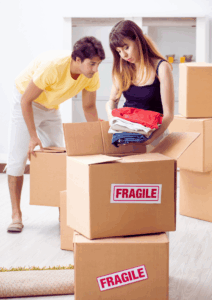
Walking into a rental property after a tenant has moved out to find that a lot of personal belongings have been left behind can be complicated. What do you do with these things? Are they yours to remove? How long do you have to keep them?
California law is pretty specific about this, and whether your tenant has been evicted, broken a lease, or moved out at the end of a lease term, the way you deal with their abandoned property requires care and attention.
We’ve put together a step-by-step guide so you know what to do and how to do it.
Legal Requirements around Abandoned Property
When rental property owners find abandoned property in a home that they have reclaimed after a tenant has moved out or been evicted, the immediate actions will depend on what type of property it is. Condiments in the refrigerator door can be thrown away. But what about the television or the sleeper sofa?
Following California law is important, otherwise those tenants can come back and make a claim against you.
Some of what’s left behind can be thrown out immediately.
- Food in the refrigerator or the pantry, for example, can be tossed.
- If there is garbage or trash, remove it from the property.
- When you find a mess that requires hauling and dumping, hire a crew, take a lot of photos, and deduct the cost from the security deposit.
Anything that is not trash will require a detailed inventory and storage until the tenant is contacted. Disposing of valuable property right away is illegal.
Under California law, landlords are required to protect any belongings left behind by a tenant for 18 days after that tenant has been issued a notice of property abandonment. Within that time period, the tenant has the opportunity to reclaim the items they left behind. If the tenant does not respond to the notice that was sent within the 18 days, then you can legally take the next steps.
Just make sure you send a notice and wait out those 18 days.
Abandoned Property Value and Storage
Estimating the worth of the property that has been abandoned is your starting point. Before you take the necessary steps towards disposal, know what you’re working with from a monetary standpoint.
This makes a legal difference in how you store and potentially dispose of the abandoned property.
In California, rental property owners can claim any abandoned items worth less than $700. Items worth more than $700 must be sold at auction, and the proceeds will go to the county where the property is located. When you’re dealing with something that’s worth more than $700 and you cannot claim it for yourself, then you do have the right to deduct reasonable costs that are paid for storage and management of these items that will be sold.
Step-By-Step Approach to Dealing with Abandoned Tenant Property
Here is what you’ll have to do when property is left behind.
Step 1: Review the Lease Agreement
First, check out what your lease agreement says about abandoned property. As local property management professionals, we always encourage the inclusion of terms and language around abandoned property. When your California lease references abandoned property, that’s where we want to start. Review what the lease says and follow any instructions or directives that are found there.
Step 2: Send Tenants a Legal Notice Regarding the Property
Once that you know how much property you’re dealing with and what it’s worth, you’ll want to send the tenants a notice that outlines what has been left behind by them, where you plan to keep it, how long you are obligated to keep it, and what they’ll need to do in order to reclaim it.
There is a template for this formal correspondence: Notice to Remove Personal Property from Premises’ in California. We can provide this to you if you can’t access it yourself. There is specific language that has to be included in the notice, so make sure you’re not omitting any pertinent details. Your steps here are to identify the property, share the storage location if you’re not keep the property inside the home they left, and provide a specific deadline for retrieval. Be clear about any costs associated with reclaiming the property, such as storage fees or hauling charges.
This notice needs to be promptly sent out, after the conclusion of a move-out inspection. We recommend that you inventory the items that may have been left behind. Then, communicate directly with your tenant about this property. The form must include information on what will happen to the belongings if the tenants do not come and claim them within the 18 days that are given.
This notice is not only legally required, it also puts everything in writing for the tenant. When you serve this notice, you know that those tenants are fully informed about the process and how to take back any of the property they may have left behind unintentionally.
Step 3: Remove the Property
 What to do with the property that your tenants might eventually reclaim? You have a few options. You can remove the abandoned items from the rental property and store them, or you can leave them at the rental home. Most owners will want to get to work turning over their unit, and that will require cleaning out the property. But, if almost everything has been left behind, that can be difficult.
What to do with the property that your tenants might eventually reclaim? You have a few options. You can remove the abandoned items from the rental property and store them, or you can leave them at the rental home. Most owners will want to get to work turning over their unit, and that will require cleaning out the property. But, if almost everything has been left behind, that can be difficult.
Once the notice period passes, you have the right to remove the items from wherever you are holding them.
When you keep the property that’s worth less than $700, there’s not much you have to do. There’s no need to document that you’ve donated or sold or thrown out those things.
But you do have to document those costly things. Those more expensive items that are over $700 have to be sold at auction to the benefit of the county. A local bond agency will have to facilitate this auction, and property owners are permitted to deduct the cost of that transaction from the proceeds of the sale.
Those are your immediate steps. But there’s more to understand around how to handle such a situation. We can help you work through any circumstance in which you find yourself with abandoned property. Please contact us at Action Properties.
